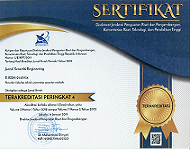Formulasi Fermentasi dalam Pembuatan Keju Nabati Berbasis Kacang Tanah dan Lemak Crude Palm Oil dengan Lactobacillus Bulgaricus dan Streptococcus Lactis
Keywords:
Keju Nabati, Crude Palm Oil (CPO) , Kacang TanahAbstract
Plant-based cheese is a plant-based food innovation designed to mimic the texture, flavor, and nutritional value of conventional cheese, but without the use of animal ingredients. This product offers a solution for individuals with lactose intolerance, vegan lifestyles, and sustainable food needs. In this study, peanuts were used as the primary protein source due to their gel-forming ability and creamy texture, while crude palm oil (CPO) served as an alternative, oxidatively stable vegetable fat source. The cheese formulation was developed by varying the ratio of CPO to peanut milk (90:10, 85:15, dan 80:20) and incubation times (6, 12, and 24 hours). Product quality analysis included pH, moisture, fat, protein, and ash content, in accordance with the Indonesian National Standard (SNI) 2980:2018. The results showed that the appropriate combination of CPO and peanut protein can produce plant-based cheese with physical and chemical characteristics close to conventional processed cheese. These findings strengthen the potential of plant-based cheese as a functional and nutritionally valuable alternative in the modern food industry.
References
[1] Badan Pusat Statistik (BPS), “Produksi kelapa sawit menurut provinsi,” 2024.
[2] V. Nurmalita and P. A. Wibowo, “Analisis faktor-faktor yang mempengaruhi ekspor minyak kelapa sawit Indonesia ke India,” Economic Education Analysis Journal, vol. 8, no. 2, pp. 605–619, 2019, doi: 10.15294/eeaj.v8i2.31492.
[3] Z. Hastuti, H. P. Dwi, and R. Erlan, “Pemanfaatan CPO Asam Lemak Bebas Tinggi Sebagai Bahan Bakar,” Jurnal Energi dan Lingkungan, vol. 11, no. 1, pp. 61–66, 2015.
[4] M. R. Harahap, A. A. Agustania, and S. Agustiar, “Analisis kadar air dan minyak dalam sampel press fibre dan kadar asam lemak pada CPO (Crude Palm Oil) di PMKS PT. X,” AMINA, vol. 2, no. 3, 2020.
[5] H. Heryani, “Penentuan kualitas degummed bleached palm oil (DBPO) dan refined bleached deodorized palm oil (RBDPO) dengan pemberian bleaching earth pada skala industri,” Jurnal Teknologi Industri Pertanian, vol. 29, no. 1, pp. 11–18, 2019, doi: 10.24961/j.tek.ind.pert.2019.29.1.11.
[6] N. Sofiana, A. Permadi, N. S. Sembiring, and E. Sulistiawati, “Review: Asam linoleat sebagai bahan baku pada formulasi kosmetik,” in Seminar Nasional Inovasi dan Teknologi (SEMNASINTEK), Universitas Ahmad Dahlan, Yogyakarta, Nov. 27, 2024.
[7] R. U. A. Nursiwi, “Fermentasi Whey Limbah Keju Untuk Produksi Kefiran oleh Kefir Grains,” Jurnal Teknologi Hasil Pertanian, vol. 8, 2015.
[8] K. Syamsu and K. Elsahida, “Pembuatan keju nabati dari kedelai menggunakan bakteri asam laktat yang diisolasi dari dadih,” Jurnal Teknologi Industri Pertanian, vol. 28, no. 2, pp. 154–161, 2018, doi: 10.24961/j.tek.ind.pert.2018.28.2.154
[9] E. C. Short, A. J. Kinchla, and A. A. Nolden, “Plant-based cheeses: A systematic review of sensory evaluation studies and strategies to increase consumer acceptance,” Foods, vol. 10, no. 4, p. 725, 2021, doi: 10.3390/foods10040725. PMID: 33808105; PMCID: PMC8066998.
[10] Direktorat Gizi Departemen Kesehatan RI, Komposisi Kimia Kacang Tanah. Jakarta: Depkes RI, 2015.
[11] E. L. Beckett, T. Cassettari, C. Starck, and F. Fayet-Moore, “Susu sapi: Ada alternatif tapi tidak ada padanannya,” Ilmu Pangan & Gizi, vol. 12, pp. 8470–8482, 2024, doi: 10.1002/fsn3.4301.
[12] Standar Nasional Indonesia (SNI) 2980:2018, Keju Olahan, BSN, 2018.
[13] Y. Abubakar and S. Usmiati, “Pengaruh substitusi lemak susu dengan minyak jagung terhadap mutu keju putih rendah lemak,” Jurnal Ilmu Peternakan Indonesia, vol. 18, no. 2, pp. 77–84, 2016.
[14] L. Nurhasanah, R. A. Nugroho, and Y. Widyastuti, “Formulasi keju vegan berbasis susu kedelai dan minyak kelapa sawit,” Jurnal Teknologi dan Industri Pangan, vol. 31, no. 2, pp. 135–144, 2020.
[15] N. M. D. Puspawati and I. M. Sugitha, “Pengaruh Perlakuan 3 Jenis Bakteri Asam Laktat dan Kombinasinya terhadap Karakteristik Keju Kedelai,” Jurnal Ilmu dan Teknologi Pangan (JITEPA), vol. 9, no. 2, pp. 141–150, 2020.
[16] C. Ardelia, T. Pantjajani, and F. Irawati, “Pembuatan keju lunak kacang merah (Phaseolus vulgaris L.) dengan proses fermentasi menggunakan Lactobacillus acidophilus,” CALYPTRA: Jurnal Ilmiah Mahasiswa Universitas Surabaya, vol. 9, no. 1, 2020.
Downloads
Published
Issue
Section
License
Copyright (c) 2025 Monica Adelya, Martha Aznury, Dilia Puspa (Author)

This work is licensed under a Creative Commons Attribution 4.0 International License.












